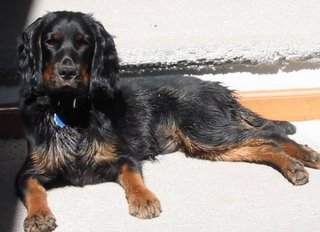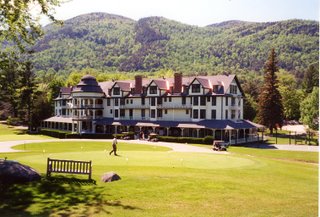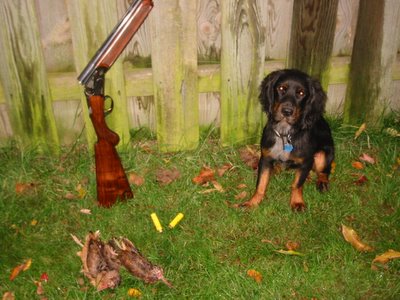
(This story first appeared in November, 2005. It's a natural for revisiting with updates until I can rename it "A Pup's First Title." The updates begin at the south end of the original text. The latest, and last, addition is dated June 10, 2007.)
November 13, 2005: Gordie and I entered his first judged events this weekend. Today we ran what is called a "Hunt Test." Many dogs are entered, but there is no single winner. It's a sort of pass/ fail event, so that at the extremes either all dogs or no dogs might receive a "qualifying score." Usually the number of those receiving qualifying scores is somewhere in between.
His job was to find and flush two birds hiding in the brush on land. After the gunners shot the first bird that Gordie flushed, he was to locate it in the field and retrieve it to me straightaway. After taking delivery of the bird, I'd send him on again, hopefully for a repeat performance on the second bird.
Later, a duck hunting scenario was fabricated where two men with a gun and a pile of the late lamented birds hid on the far side of a middling size pond. They blew a duck call to get each dog's attention. Then they tossed a dead bird through the air into the pond and touched off the shotgun to simulate an actual duck hunting event. The dog is to swim out, find the bird, and swim back and deliver it to the handler.
14 month old Gordie did all this with a flourish, and won his first qualifying score toward Junior Hunter. With three more, he gets to wear the title "JH" in all his correspondence, kind of like the Duke of Earl. We intend to travel through Canadian border and Middle Atlantic states beginning again next Spring to nail down these qualifying scores. In the meantime, we'll continue to enjoy our hunting season.

April 22, 2006: Gordie and I traveled to the Hillendale Club in central Pennsylvania to run in the junior division of the Mid Penn English Springer Spaniel Club's licensed hunt test. Although I wanted to run him both days, plans at home for Sunday limited us to the Saturday event.
The grounds, cover and valley views at the Hillendale Club were outstanding, even in the rainy 47 degrees in which we huddled over our check-in coffee. The tests were sequentially scheduled, with 8 Masters running first, then 8 Seniors, with 12 Juniors bringing up the rear. Gordie ran 27th of the 28 entries, so it was 12:30 before we saw action. His quartering was brisk, his marks just fine, and his first retrieve perfect. Gord dumped his second delivery a bit short, but recovered with a minimum of cajoling to bring the quite dead and soggy chukar within a long step. We were rewarded for this performance with a call-back for the water work.
At the water, Gordie executed an "expectant hup" as the gunners arced one of the dead chukars from the giant "sling shot" and touched off a 12 gauge. His entry was crisp and eager after the judge tapped my shoulder, and out he went in his pleasing, "low slung" and direct style in the water. In my limited experience, he seems as comfortable in the water as any young dog I've ever seen.
When Gordie arrived at the poorly floating bird, he somehow whiffed on the retrieve and dunked the bird underwater. Undeterred, Gordie began a series of shallow dives looking for it. Happily, the bird bobbed up, Gordie grabbed it, and 15 seconds later the three of us were united on the bank.
At 4:30, over a warming tot of adult beverage and much mutual back slapping, I received Gordie's rosette for this second qualifying score. I'd have 5 pleasant hours in the car through the Allegheny Forest to mentally review his performance, make mental adjustments in his training regimen, and make plans for his next test.
June 10, 2007: OK, I have to fess up from the get-go. I should have put this post here when Gordie and I returned home from two days of testing in north central CT over Memorial Day, 2006. Gordie performed at both ends of the excellence scale, and exposed my weaknesses as a trainer. I spent the rest of 2006 thinking about his performances, and only today did I have the chance to test my plan for improving them. Let me explain.
On Day 1 of the CT test, Gordie ran a wonderful land series. He quartered well, found his birds, made strong marks and finds right on the money. It was a very warm day, and the vegetation was green and thick. The judges therefore excused his stopping 10 feet short and dropping his birds (chukars) in a fit of panting. Upon urging, he picked up each bird and brought it to an acceptable 1-step distance. So far, so good. As a hunter, I was pleased with his performance, as it would have nicely put two birds in our bag.
It was therefore with a mildly excusable cockiness that I enjoyed holding forth at lunch and as we milled about for our turns at the water. When his number was called, Gordie was rock steady at the line, and made a beautiful, aggressive water entry. He was out like a shot and back, carrying the bird in the shallows 15 feet from earning his third qualifying score. Then, to my surprise, the gallery’s laughter and the judges’ distaste, Gordie started tossing the bird in the air like some Iron Chef twirling pizza dough overhead in frenzied competition. Once, twice, three times and more, up and out went the soggy chukar, with Gordie in hot pursuit for another go. After this had gone on for maybe three minutes, the inevitable “Ahem. Mr. M., you may pick up your dog” came. Thanks for coming, drive home safely. Good Night.
About an hour later, I snitched a dead chukar, went to a similar shoreline on a different pond, and tried this again mano a cano. I even stood farther back from the bank than usual to remind Gordie that the retrieve didn't end at the water's edge. Of course, Gordie made a perfect retrieve and delivered the bird thoughtfully to hand. No wonder Keith Erlandson described them as “wicked Cockers.” At least I could enjoy a pleasant evening meal and expect better results tomorrow.

It really was an attractive entry
On Day 2, Gordie ran an even better land series. A fellow whose family name is well regarded in eastern spaniel circles asked me who had trained Gordie. When I told him that the fault was all mine, he was complimentary not only about Gordie’s pattern, but at the apparent strength of our partnership. He had noticed the way Gordie happily heeled to the line, kept his eyes riveted on me when hupped at the line, and how he ran today requiring virtually no whistle commands. It was, of course, very nice to hear. Here’s how a chukar taking off looked to Gordie. He picked the bird cleanly when it fell back in that tree line moments later.

Once again, though, the day was spoiled by failure at the water. Gordie made short work of bringing his bird back to shore; but once there, he released it to shake and was reluctant to bring it to me. After some cajoling over 90 seconds, he finally brought the bird within a step. I took the bird, and the judges told me they’d let me know. I’m still waiting.
In the months after May, 2006, I thought about Gordie’s poor delivery. Since I don’t feel confident with my ability to force train him – I have only a little trouble with the idea of force training, but I am not interested in its benefits if I can’t do the training myself. Since he is a decent hunting companion, I am reluctant to possibly mess up the acceptably “country broke” dog I already have by gumming up the force training regimen – I am seeking some other way to “reach” this otherwise cooperative and, some say, naturally talented dog. The idea came to me in March, 2007.
We were swapping the trainer/ gunner roles in a field out back during a nice break in the late winter weather. My buddy must have fringed a chukar Gordie flushed with only a pellet or two. When Gordie went to the fall, he caught the running bird and brought it toward me and prepared to set it down 10 feet short, currently "as usual." When the bird started to run off, he scooped it up, moved to a safe spot once again about 10 feet off, and set it down again. This time, Gordie caught the bird as soon as it started to run and, as if he sensed that shenanigans were in his birthright but not this bird’s, brought it to me to put an end to the chukar’s nonsense.
Because I was still hot about the incomplete retrieve, the possibilities this posed for training didn’t hit me immediately. Over time, though, I decided that with the next opportunity, I’d set out a wing-clipped bird as his first contact. Maybe chasing the bird and discovering the need to hold on to it would help his delivery. So when our club met today for a simulated test/ trial, I had the planter set out a wing-clipped chukar, and asked him to be ready to roll in a flyer only if Gordie successfully delivered the wing-clip to within 1 step. The results were incredible.
Gordie had a good set of chases before he nabbed the chukar, and then he not only brought it all the way in, he hupped right in front of me with the still-struggling bird held gently in his mouth. Wow! I gave the planter the wing-clipped chukar and indicated to everyone that we’d try a flyer. The gunner made a good shot to give Gordie about a 40 yard chance. He has shown repeatedly that such finds are no trouble at all for him, and it wasn’t this time. Boy, was I happy when he did a reprise of the delivery hupped at my feet.
I knew that I should quit right then and there “with a winner.” Since it was a fairly hot day though, specially for one wearing a fur coat, I decided I’d take a dead chukar and let Gordie have a refreshing water retrieve in the pond. Pushing my luck, I hupped Gordie about 20 feet from the pond’s bank, then set the chukar down half way between. Gordie stared at the bird but didn’t budge. So I tossed the bird, counted to three, and released him. When he exited the pond, I was back at the spot 20 feet away. He brought the bird smartly toward me, then… hupped right before me and offered me the bird!! To reward him, I loved him up with petting and soft words, and then, never taking the bird from him, let him proudly parade at heel back to his crate with his prize visible for all to see.
I have no idea whether it was my plan with the wing-clip, whether Gordie is simply gaining a bit of maturity, or whether the planets were aligned just so. But Gordie behaved perfectly. I intend to try this technique several times when the weather cools later in the summer and we're planning our testing schedule for the Fall. Check back now and then to see how we're doing.













































